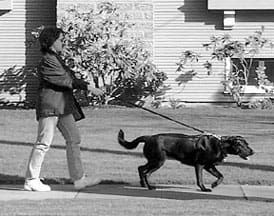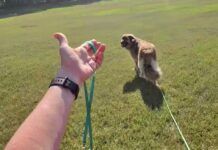It’s a never-ending quest – like looking for the Holy Grail – the search for the perfect piece of humane equipment that will teach your dog not to pull on the leash. Here’s a tip: it doesn’t exist.
Any piece of equipment is merely a tool that opens a training window for you. To use it correctly, you must take advantage of that open window to reinforce the behavior that the tool encourages the dog to offer. If you fail to consistently reward the desired behavior when it happens, the tool becomes a crutch that you rely on to make the behavior happen. In worst case scenarios, the dog learns to ignore the tool and reverts to his former behavior even with it on.
What you want, instead, is for the dog to learn the desired behavior – not pulling – so you can wean him off the tool and still have him offer the desired behavior, independent of the presence of the piece of equipment.

This is not a new phenomenon, or one specific to positive training. Many dog owners who train with compulsion methods are dismayed to realize that some dogs quickly learn that they only have to respond when the choke chain (or prong collar, or shock collar) is on. Other dogs learn to lean into a choke chain or prong collar and ignore the pressure or pain that it applies to their necks, just as some dogs learn to lean into a head halter or no-pull harness.
That doesn’t mean those tools are worthless. It means that you must disregard the claims on the label and it means that you will have to actually train your dog – not rely on the equipment you use to do the job for you.
That said, let’s take a look at two of the many types of products currently on the market that claim to make your dog stop pulling on the leash.
No-pull harnesses
No-pull harnesses work on the principle of negative reinforcement, that is, the dog’s behavior makes a bad thing (varying from mild discomfort to a painful pinching) go away.
All three of the no-pull harnesses we found in catalogs and stores fit around the neck and chest or legs of the dog. When the dog pulls, the harnesses tighten around the dog’s chest or legs. This causes discomfort to the dog, depending on how hard he pulls and his individual sensitivity level, or the dog may simply react to the novelty of the sensation of pressure. When the dog stops pulling, the “bad thing” – the pressure – goes away.
If, at that moment, you Click! and reward the dog for being on a loose leash, you will mark and reinforce the desired behavior. If you then continue to Click! and reward him for keeping the leash loose, you will use the no-pull harness as it should be used – as a training tool.
But if you wait until he is leaning into the harness again, and rely on the equipment to stop him from pulling every time, you are using it as a crutch. In this case, it’s unlikely that he will ever learn to walk nicely on a leash without the harness, especially if he is already a dedicated puller.
Best no-pull training harness
We were only able to find three no-pull harnesses on the commercial market. Of these, only one gets our top rating of 4 Paws: The J.S. Sporn Halter, produced by Yuppie Puppy Pet Care, Inc. in New York, New York. This harness is well-designed and made of high quality materials. It is the easiest of the three to put on the dog – the red nylon collar snaps around the dog’s neck like a regular collar, and nylon cords run through a ring on the back of the collar, under the dog’s front legs, and back up to the front of the collar. Sherpa sleeves fit over the cord and rest under the dog’s armpits so the cord doesn’t rub.
One of the important differences between the Sporn Halter and the other brands is that the leash attaches to the cords at the dog’s neck. This provides a greater degree of control than the others, which attach over the middle of the dog’s back and allow the dog to spin on the leash.
Another important design feature is the collar itself, which prevents the dog from pulling backwards out of the harness – a disturbing and dangerous phenomenon that we discovered with at least one of the other two brands.
A drop in rating
Our regard for the next two products is considerably lower than for the Sporn Harness.
The Pro-Stop! Gentle Restraining Harness, from Ethical Products, Inc. in Newark, New Jersey, uses a slightly different concept to discourage pulling. One strap of the harness fits around the dog’s midsection just behind the shoulders, and a neoprene-padded strap snaps around each of the dog’s front legs, just above the elbow. The leg strap from each side runs up the harness and through a metal “D” ring near the top, and the straps join at a loose ring, to which the leash is attached. Another strap at the top links the harness to the dog’s regular collar, to prevent the harness from sliding down the dog’s back. When the dog pulls, the straps around the legs tighten, ostensibly causing the dog to stop pulling.
The Pro-Stop! is somewhat more difficult to put on the dog than the Sporn Halter. While most dogs are accustomed to having a collar put on their necks, it is more of a challenge to buckle a strap around a dog’s midsection – especially one who is bouncing about in anticipation of a walk. Some of the materials of this harness appear to be of a slightly lesser quality than the Sporn: the nylon is thinner, narrower, and not as soft, and the leg padding is a thin neoprene material that appears less durable than the padding on the Sporn Halter.
Our least favorite feature of the Pro-Stop!, however, is that, since the straps tighten around the dog’s legs, they actually impede the dog’s normal range of motion. While some of our test dogs appeared undisturbed by this, others were quite perturbed, and resisted moving forward at all.
The Holt Control Harness, from Coastal Pet Products in Alliance, Ohio, is the least expensive of the three no-pull harnesses, and our tests demonstrated why.
First, it is the most difficult to put on the dog. It consists simply of two connected openings, one large, one small, formed by a nylon cord threaded through a number of pieces of metal hardware. The nylon loops slip over the dog’ head, then the dog’s front legs have to be physically manipulated through the appropriate openings, which, again, can be difficult with an active dog.
The instructions are somewhat difficult to follow, with various references to letters indicated on the accompanying diagram. The materials are of lesser quality than the other two harnesses, and there is no padding to protect the dog’s sensitive underarm area from chafing.
Our greatest concern with the Holt Harness is the combination of the mid-back connection which allows the dog to spin on the leash, and the absence of any attachment to a real collar. This means that a determined dog can spin, pull back, slip out of the harness and run free. Definitely a serious design flaw!
Discouraging noises?
Well-designed no-pull beeps or whistles can work well as a positive training tool for some dogs – especially those who are intrigued by high-pitched squeaky toy noises.
How well noisemakers work in no-pull applictions is less clear. We found two noise-based, no-pull training products, and both purport to train the dog not to pull simply on the basis of the emitted sound. This is just plain impossible, especially since neither of the noises emitted by these products are particularly unpleasant or aversive.
It is imperative that you reinforce the dog with a reward when he pauses at the sound emitted by the product. The sound itself is not inherently reinforcing to the dog; it is simply a behavior interrupter, or attention-getter. He will learn to ignore the beep or whistle if it is not paired with a reward – preferably a treat – at least at first. Good no-pull noisemakers utilize the principle of positive reinforcement, in which the dog’s behavior (not pulling), makes a good thing (the reward) happen.
Don’t follow the directions
We think the Happy Walker Leash Trainer by Amtek Pet Behavior Products, of San Diego, California, can be a useful training tool, although, for the reasons listed above, we would use it a little differently than the maker describes in the package directions.
The Happy Walker attaches to your regular leash with two rubber retaining rings. A small button on the Walker rests against the leash, and when the dog pulls, the leash presses the button, causing the device to make a loud, high pitched “Beep”!
Amtek describes the beep as an aversive, and says the dog will learn to stop pulling in order to avoid making the beep happen. Our test dogs liked the beep – like the squeaker of a plush toy. In fact, when we pushed the button manually, they all ran over to see what was making the noise. Therefore, the beep is more of a positive interrupt than an aversive – the dog pauses to check out the sound, which gives you the opportunity to Click! and reward for the loose leash.
If you then seize the window of opportunity to continue clicking and rewarding for the loose leash, rather than waiting for the dog to pull and make the beep happen again, you are training the dog to walk on a loose leash rather than using the Happy Walker as a crutch.
The device comes with a miniature 12-volt battery, and if used properly, you should never have to replace it – your dog will learn to walk on a loose leash long before you wear the battery down.
We would encourage Amtek to change their packaging. They claim that the Happy Walker “automatically” stops dogs from pulling on leash – thereby encouraging its use as a crutch rather than a real training tool. If they rewrote that and their instructions for use, we’d have no complaints at all!
A whistle (and a yank)
At the other end of the sound-gadget spectrum is the Wonder Whistle from K-II Enterprises in Syracuse, New York. This is a sturdy, tubular plastic whistle that snaps to the dog’s collar ring at one end. Your leash snaps onto to the other end. It works mechanically, not electronically, and requires a sharp jerk on the leash to sound the device’s whistle. While the company states that the “Toot” of the whistle causes the dog to stop pulling, we suspect that the old “jerk on the collar” is responsible for at least as much improvement in the dog’s leash manners as the “Toot” is. Since we don’t condone the use of force in training, we don’t recommend you try the Wonder Whistle in its present form. We do like the idea of a sound device that doesn’t need batteries, however, and if the company could considerably reduce the amount of pressure needed to make the whistle sound so that it didn’t require a jerk on the leash, they might be on to something!






